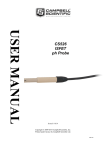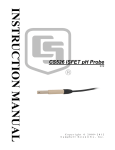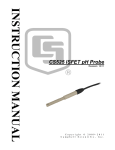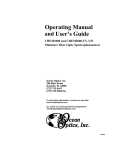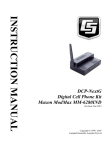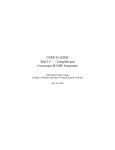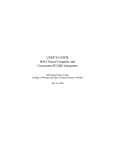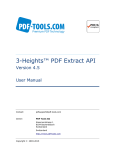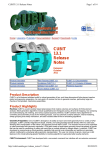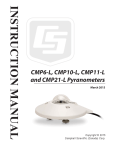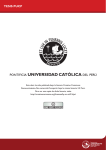Download Campbell CS526 Instruction manual
Transcript
INSTRUCTION MANUAL CS526 ISFET pH Probe Revision: 4/15 C o p y r i g h t © 2 0 0 9 - 2 0 1 5 C a m p b e l l S c i e n t i f i c , I n c . Limited Warranty The CS526 ISFET pH Probe is warranted for six (6) months subject to this limited warranty: “Products manufactured by CSI are warranted by CSI to be free from defects in materials and workmanship under normal use and service for twelve months from the date of shipment unless otherwise specified in the corresponding product manual. (Product manuals are available for review online at www.campbellsci.com.) Products not manufactured by CSI, but that are resold by CSI, are warranted only to the limits extended by the original manufacturer. Batteries, fine-wire thermocouples, desiccant, and other consumables have no warranty. CSI’s obligation under this warranty is limited to repairing or replacing (at CSI’s option) defective Products, which shall be the sole and exclusive remedy under this warranty. The Customer assumes all costs of removing, reinstalling, and shipping defective Products to CSI. CSI will return such Products by surface carrier prepaid within the continental United States of America. To all other locations, CSI will return such Products best way CIP (port of entry) per Incoterms ® 2010. This warranty shall not apply to any Products which have been subjected to modification, misuse, neglect, improper service, accidents of nature, or shipping damage. This warranty is in lieu of all other warranties, expressed or implied. The warranty for installation services performed by CSI such as programming to customer specifications, electrical connections to Products manufactured by CSI, and Product specific training, is part of CSI's product warranty. CSI EXPRESSLY DISCLAIMS AND EXCLUDES ANY IMPLIED WARRANTIES OF MERCHANTABILITY OR FITNESS FOR A PARTICULAR PURPOSE. CSI hereby disclaims, to the fullest extent allowed by applicable law, any and all warranties and conditions with respect to the Products, whether express, implied or statutory, other than those expressly provided herein.” Assistance Products may not be returned without prior authorization. The following contact information is for US and international customers residing in countries served by Campbell Scientific, Inc. directly. Affiliate companies handle repairs for customers within their territories. Please visit www.campbellsci.com to determine which Campbell Scientific company serves your country. To obtain a Returned Materials Authorization (RMA), contact CAMPBELL SCIENTIFIC, INC., phone (435) 227-9000. After an application engineer determines the nature of the problem, an RMA number will be issued. Please write this number clearly on the outside of the shipping container. Campbell Scientific’s shipping address is: CAMPBELL SCIENTIFIC, INC. RMA#_____ 815 West 1800 North Logan, Utah 84321-1784 For all returns, the customer must fill out a “Statement of Product Cleanliness and Decontamination” form and comply with the requirements specified in it. The form is available from our web site at www.campbellsci.com/repair. A completed form must be either emailed to [email protected] or faxed to (435) 227-9106. Campbell Scientific is unable to process any returns until we receive this form. If the form is not received within three days of product receipt or is incomplete, the product will be returned to the customer at the customer’s expense. Campbell Scientific reserves the right to refuse service on products that were exposed to contaminants that may cause health or safety concerns for our employees. Precautions DANGER — MANY HAZARDS ARE ASSOCIATED WITH INSTALLING, USING, MAINTAINING, AND WORKING ON OR AROUND TRIPODS, TOWERS, AND ANY ATTACHMENTS TO TRIPODS AND TOWERS SUCH AS SENSORS, CROSSARMS, ENCLOSURES, ANTENNAS, ETC. FAILURE TO PROPERLY AND COMPLETELY ASSEMBLE, INSTALL, OPERATE, USE, AND MAINTAIN TRIPODS, TOWERS, AND ATTACHMENTS, AND FAILURE TO HEED WARNINGS, INCREASES THE RISK OF DEATH, ACCIDENT, SERIOUS INJURY, PROPERTY DAMAGE, AND PRODUCT FAILURE. TAKE ALL REASONABLE PRECAUTIONS TO AVOID THESE HAZARDS. CHECK WITH YOUR ORGANIZATION'S SAFETY COORDINATOR (OR POLICY) FOR PROCEDURES AND REQUIRED PROTECTIVE EQUIPMENT PRIOR TO PERFORMING ANY WORK. Use tripods, towers, and attachments to tripods and towers only for purposes for which they are designed. Do not exceed design limits. Be familiar and comply with all instructions provided in product manuals. Manuals are available at www.campbellsci.com or by telephoning (435) 227-9000 (USA). You are responsible for conformance with governing codes and regulations, including safety regulations, and the integrity and location of structures or land to which towers, tripods, and any attachments are attached. Installation sites should be evaluated and approved by a qualified engineer. If questions or concerns arise regarding installation, use, or maintenance of tripods, towers, attachments, or electrical connections, consult with a licensed and qualified engineer or electrician. General • Prior to performing site or installation work, obtain required approvals and permits. Comply with all governing structure-height regulations, such as those of the FAA in the USA. • Use only qualified personnel for installation, use, and maintenance of tripods and towers, and any attachments to tripods and towers. The use of licensed and qualified contractors is highly recommended. • Read all applicable instructions carefully and understand procedures thoroughly before beginning work. • Wear a hardhat and eye protection, and take other appropriate safety precautions while working on or around tripods and towers. • Do not climb tripods or towers at any time, and prohibit climbing by other persons. Take reasonable precautions to secure tripod and tower sites from trespassers. • Use only manufacturer recommended parts, materials, and tools. Utility and Electrical • You can be killed or sustain serious bodily injury if the tripod, tower, or attachments you are installing, constructing, using, or maintaining, or a tool, stake, or anchor, come in contact with overhead or underground utility lines. • Maintain a distance of at least one-and-one-half times structure height, 20 feet, or the distance required by applicable law, whichever is greater, between overhead utility lines and the structure (tripod, tower, attachments, or tools). • Prior to performing site or installation work, inform all utility companies and have all underground utilities marked. • Comply with all electrical codes. Electrical equipment and related grounding devices should be installed by a licensed and qualified electrician. Elevated Work and Weather • Exercise extreme caution when performing elevated work. • Use appropriate equipment and safety practices. • During installation and maintenance, keep tower and tripod sites clear of un-trained or nonessential personnel. Take precautions to prevent elevated tools and objects from dropping. • Do not perform any work in inclement weather, including wind, rain, snow, lightning, etc. Maintenance • Periodically (at least yearly) check for wear and damage, including corrosion, stress cracks, frayed cables, loose cable clamps, cable tightness, etc. and take necessary corrective actions. • Periodically (at least yearly) check electrical ground connections. WHILE EVERY ATTEMPT IS MADE TO EMBODY THE HIGHEST DEGREE OF SAFETY IN ALL CAMPBELL SCIENTIFIC PRODUCTS, THE CUSTOMER ASSUMES ALL RISK FROM ANY INJURY RESULTING FROM IMPROPER INSTALLATION, USE, OR MAINTENANCE OF TRIPODS, TOWERS, OR ATTACHMENTS TO TRIPODS AND TOWERS SUCH AS SENSORS, CROSSARMS, ENCLOSURES, ANTENNAS, ETC. Table of Contents PDF viewers: These page numbers refer to the printed version of this document. Use the PDF reader bookmarks tab for links to specific sections. 1. Introduction ................................................................. 1 2. Cautionary Statements ............................................... 1 3. Initial Inspection ......................................................... 2 4. Quickstart .................................................................... 2 4.1 4.2 Preparation for Use and Installation ..................................................... 2 Use SCWin to Program Datalogger and Generate Wiring Diagram .... 2 5. Overview ...................................................................... 5 6. Specifications ............................................................. 5 7. Operation ..................................................................... 6 7.1 7.2 Wiring .................................................................................................. 6 Datalogger Programming ..................................................................... 7 7.2.1 Get Data Command ...................................................................... 7 7.2.2 CRBasic Instruction Sequence ...................................................... 7 7.2.3 Instruction Descriptions ................................................................ 8 7.2.3.1 SerialOpen() Instruction ..................................................... 8 7.2.3.2 SerialOut() Instruction........................................................ 8 7.2.3.3 SerialIn() Instruction .......................................................... 8 7.2.3.4 SplitStr() Instruction ........................................................... 9 7.2.4 Programming for Calibration ........................................................ 9 7.3 Calibration............................................................................................ 9 8. Troubleshooting.......................................................... 9 9. Maintenance .............................................................. 10 9.1 Cleaning ............................................................................................. 10 9.1.1 When to Clean ............................................................................ 10 9.1.2 Cleaning Procedure ..................................................................... 11 9.1.2.1 Cleaning Tips ................................................................... 12 9.1.3 Revitalizing ................................................................................. 12 9.2 Storage ............................................................................................... 12 9.2.1 Short-Term Storage (2 days or less) ........................................... 12 9.2.2 Long-Term Storage (more than 2 days) ...................................... 12 Appendices A. Importing Short Cut Code ...................................... A-1 i Table of Contents A.1 Importing Short Cut Code into a Program Editor............................ A-1 B. Example Program.................................................... B-1 C. Calibration ............................................................... C-1 C.1 Example Calibration Program ......................................................... C-2 9-1. Tip of the CS526 probe ..................................................................... 11 7-1. 7-2. 7-3. 7-4. Wiring ................................................................................................. 6 “Get Data” Command and Response .................................................. 7 Instruction Sequence ........................................................................... 7 Calibration Standards .......................................................................... 9 Figures Tables ii CS526 ISFET pH Probe 1. Introduction The CS526 ISFET pH Probe measures pH from 1 to 14 in aqueous or semisolid solutions. It outputs TTL serial data that is read by compatible dataloggers (see Section 6, Specifications (p. 5)). Before using the CS526, please study • • • Section 2, Cautionary Statements (p. 1) Section 3, Initial Inspection (p. 2) Section 4, Quickstart (p. 2) More detailed instructions for operation, troubleshooting, and maintenance are available in the remaining sections. 2. Cautionary Statements • READ AND UNDERSTAND the Precautions section at the front of this manual. • Campbell Scientific warranty does not cover a clogged reference diaphragm or improperly cleaned or maintained ISFET chip (see Section 9, Maintenance (p. 10)). • Maximum input voltage is 5 Vdc. Incorrect wiring may cause performance loss and irreversible damage. • To prevent scratching the sensor chip when cleaning, first soak the sensor in soapy water and then gently scrub with a toothbrush (see Section 9, Maintenance (p. 10)). Most scratches occur when hard particles are rubbed on the chip surface. Scratches cause irreversible damage to the probe. • Do not use hydrofluoric acid, acetone, MEK, or similar agents to clean the probe. • Cable can be damaged by abrasion, rodents, sharp objects, twisting, crimping or crushing, and pulling. Take care during installation and use to avoid cable damage. • The CS526 is rugged, but it should be handled as a precision scientific instrument. • The CS526 has no user-serviceable parts. Any attempt to disassemble the device will void the six-month warranty. • Care should be taken when opening the shipping package to not damage or cut the cable jacket. If damage to the cable is suspected, consult with a Campbell Scientific application engineer. 1 CS526 ISFET pH Probe 3. Initial Inspection Upon receipt of the CS526, inspect the packaging and contents for damage. File damage claims with the shipping company. The model number and cable length are printed on a label at the connection end of the cable. Check this information against the shipping documents to ensure the correct product and cable length are received. 4. Quickstart For complete installation, programming, and calibration information, see Sections 7.1 Wiring (p. 6), through 7.3, Calibration (p. 9). 4.1 Preparation for Use and Installation 1. Soak the CS526 in 7-pH buffer solution for 15 minutes. 2. Follow the calibration procedure outlined in Appendix C, Calibration (p. C-1). 3. Place the CS526 in the liquid being measured. The CS526 ISFET pH probe can be installed without regard to orientation. NOTE 4.2 When installing in a well, the 7421 Split Mesh Cable grip is recommended to center and suspend the cable, reducing cable stretch. Use SCWin to Program Datalogger and Generate Wiring Diagram Short Cut is an easy way to program your datalogger to measure the CS526 and assign datalogger wiring terminals. The following procedure shows using Short Cut to program the CS526. 2 1. Install Short Cut by clicking on the install file icon. Get the install file from either www.campbellsci.com, the ResourceDVD, or find it in installations of LoggerNet, PC200W, PC400, or RTDAQ software. 2. The Short Cut installation should place a Short Cut icon on the desktop of your computer. To open Short Cut, click on this icon. CS526 ISFET pH Probe 3. When Short Cut opens, select New Program. 4. Select Datalogger Model and Scan Interval (default of 5 seconds is OK for most applications). Click Next. 3 CS526 ISFET pH Probe 5. Under the Available Sensors and Devices list, select the Sensors | Water | Quality folder. Select CS526 ISFET pH Probe. Click selection to the Selected device window. 4 to move the 6. After selecting the sensor, click at the left of the screen on Wiring Diagram to see how the sensor is to be wired to the datalogger. The wiring diagram can be printed out now or after more sensors are added. 7. Select any other sensors you have, then finish the remaining Short Cut steps to complete the program. The remaining steps are outlined in Short Cut Help, which is accessed by clicking on Help | Contents | Programming Steps. CS526 ISFET pH Probe 5. 8. If LoggerNet, PC400, or PC200W is running on your PC, and the PC to datalogger connection is active, you can click Finish in Short Cut and you will be prompted to send the program just created to the datalogger. 9. If the sensor is connected to the datalogger, as shown in the wiring diagram in step 6, check the output of the sensor in the datalogger support software data display to make sure it is making reasonable measurements. Overview The CS526 uses SENTRON’s high-tech, Ion Sensitive Field Effect Transistor (ISFET) semi-conductor as its pH-sensitive element, and includes a silver/silver chloride – potassium chloride reference system. The CS526’s design allows it to be suitable for a variety of liquid pHmonitoring applications. Its electronics are safely embedded in a durable PEEK body. Elimination of the glass-bulb removes the possibility of broken glass, making the CS526 more rugged and safer to use. NOTE The CS526 is shipped dry and therefore must be soaked in pH solution before use. The CS526’s cable can terminate in: 6. • Pigtails that connect directly to a Campbell Scientific datalogger (cable termination option –PT). • Connector that attaches to a prewired enclosure (cable termination option –PW). Specifications Features: • Safety—the ISFET with durable PEEK material can be used safely in applications where broken glass is a hazard to the user. • Intelligent electronics—the CS526 combines the latest developments in ISFET pH sensing technology with state-of-the-art signal processing. This allows for accurate, fast and reliable results. • Quality—designed and manufactured under stringent quality control conditions in an ISO 9001 environment. Each sensor is individually tested to the most demanding testing protocols, and the electronics comply fully with directives and with EMC standard IEC61326:2005. • Compatible with Campbell Scientific CRBasic dataloggers: CR6, CR800 series, CR1000, and CR3000 Measurement Range: Accuracy: 24 hr drift: 2 to 12 pH ±0.2 pH with 2-point calibration <0.15 pH (after 15-min soak in pH 7 at 25 °C) 5 CS526 ISFET pH Probe Operating Temperature: Water Pressure: 10 to 40 °C 0 to 700 kPa (0 to 101.5 psi) Power Requirement Source: Load: 5 Vdc 15 mA maximum Output: TTL logic, 2400 bps 8 data bits, no parity, 1 stop bit Maximum Cable Length: 100 m (328 ft) Cable Type: Three-twisted pair, 24-AWG cable with Santoprene jacket Sensor Material: PEEK Weight w/10-ft cable: 318 g (11.2 oz) Dimensions Length: Diameter: 102 mm (4 in) 16 mm (0.63 in) Certifications: 7. ISO 9001 compliant EMC standard IEC61326:2005 Operation If you are programming your datalogger with Short Cut, skip Section 7.1, Wiring (p. 6), and Section 7.2, Datalogger Programming (p. 7). Short Cut does this work for you. See Section 4, Quickstart (p. 2), for a Short Cut tutorial. 7.1 Wiring TABLE 7-1. Wiring 6 Wire Color Wire Label/Function Datalogger Connections Red (see following caution) Power 5V 5V Black Ground G White Rx Control Port (odd numbered) Green Tx Control Port (even numbered) Clear Shield G CS526 ISFET pH Probe CAUTION 7.2 This probe must be connected to the datalogger’s 5 V terminal (not 12 V). Connecting to a higher voltage will damage the probe beyond repair. Datalogger Programming 7.2.1 Get Data Command The datalogger needs to send a “get data” serial command to the CS526 to get the pH data. This command is sent to the CS526 via the SerialOut() CRBasic instruction (see Section 7.2.3.2, SerialOut() Instruction (p. 8)). TABLE 7-2 shows the “get data” command and its response. TABLE 7-2. “Get Data” Command and Response Command Response aMn!<CR> a<value><CR><LF> Where: a = probe address (factory default is 1) n = a single dummy character (typically use 1) Where: a = probe address (factory default is 1) <value> = the probe’s reading for pH (in digital counts). 7.2.2 CRBasic Instruction Sequence A sequence of CRBasic instructions is used to measure the sensor. TABLE 7-3 shows the instruction sequence. Information about the instructions is provided in Section 7.2.3, Instruction Descriptions (p. 8), and an example program is provided in Appendix B, Example Program (p. B-1). TABLE 7-3. Instruction Sequence Instruction Function SerialOpen() Set up a datalogger port for serial communication (see Section 7.2.3.1, SerialOpen() Instruction (p. 8)) Scan() Establish a scan rate SerialOut() Send “get data” command to the CS526. See Section 7.2.1, Get Data Command (p. 7), and 7.2.3.2, SerialOut() Instruction (p. 8), for more information. SerialIn() Set up the COM port to receive the incoming serial data (see Section 7.2.3.3, SerialIn() Instruction (p. 8)). Please note that in the beginning of the CRBasic program, the variable used in the SerialIn() instruction needs to be declared as an ASCII string format. SplitStr() Split out digital count value for pH from the input string. 7 CS526 ISFET pH Probe NOTE Probe output is “Counts”. A corrected multiplier and offset are required to provide an output in pH units (see Appendix C, Calibration (p. C-1)). 7.2.3 Instruction Descriptions 7.2.3.1 SerialOpen() Instruction The SerialOpen() instruction has the following syntax: SerialOpen(ComPort,BaudRate,Format,TXDelay,BufferSize) ComPort—the datalogger COM port in which the probe is connected. BaudRate—choose 2400 Format—choose 16, which is TTL Logic; No parity, one stop bit, 8 data bits; No error checking TXDelay—enter 0 BufferSize—enter at least twice the number of maximum expected characters + 1, which is 41. 7.2.3.2 SerialOut() Instruction The SerialOut() instruction has the following syntax: SerialOut(ComPort,OutString,WaitString,NumberTries,TimeOut) ComPort—the datalogger COM port in which the probe is connected. OutString—use "1M1!"+CHR(13) for the OutString when the default probe address of 1 is used. WaitString—enter the null (“”) WaitString to tell the datalogger to wait for the echo of each character in the OutString NumberTries—enter 0 TimeOut—specifies the time, in 0.01 seconds, that the datalogger should wait for the WaitString or echo of each character in the OutString (0 is used in the example program). 7.2.3.3 SerialIn() Instruction The SerialIn() instruction has the following syntax: SerialIn(Dest,ComPort,TimeOut,TerminationChar,MaxNumChars) Dest—specifies the variable in which the incoming data will be stored. Please note that in the beginning of the CRBasic program, this variable needs to be declared as ASCII string format (see example program in Appendix B, Example Program (p. B-1)) ComPort—the datalogger COM port in which the probe is connected. TimeOut—20 should be adequate, which gives a 200 ms maximum delay time. The TimeOut parameter is used to specify the amount of time, in 0.01 seconds, that the datalogger should wait before proceeding to the next instruction. TerminationChar—enter 0 MaxNumChars—20 should be adequate (specify the maximum number of characters to expect per input) 8 CS526 ISFET pH Probe 7.2.3.4 SplitStr() Instruction The SplitStr() instruction has the following syntax: SplitStr(SplitResult,SearchString,FilterString,NumSplit,SplitOption) SplitResult—an array in which the split string will be stored. SearchString—the string on which this instruction will operate. This will be the variable entered for the Dest parameter for the SerialIn() instruction (see above). FilterString—enter “String” (this value will be ignored because of the SplitOption that will be used). NumSplit—enter 2 SplitOption—enter 0. This splits out numeric values. 7.2.4 Programming for Calibration To output in pH units instead of digital counts, enter the offset and multiplier into the datalogger program. Simple program instructions can be used to make the required periodic calibration easier. See Appendix C, Calibration (p. C-1), for an example program. 7.3 Calibration Calibration should be carried out according to the detailed procedure outlined in Appendix C, Calibration (p. C-1). The calibration should use two or more pH standards, listed in TABLE 7-4, which are available from Campbell Scientific. TABLE 7-4. Calibration Standards pH Part Number 4 25587 7 25586 10 25588 Frequency of calibration depends on the level of accuracy required and the coating / fouling nature of the measured samples. 8. Troubleshooting NOTE Follow the procedure provided by the Assistance section at the beginning of this document if the CS526 is not operating properly and requires return to Campbell Scientific. The most common causes for erroneous pH data include: • • • • poor sensor connections to the datalogger damaged cables scratched chip contaminated or clogged diaphragm 9 CS526 ISFET pH Probe Problem: Output signal is at its maximum value. Possible reasons: o Probe is not in fluid. o Chip is polluted. o Diaphragm is polluted. o Chip is scratched. Suggestions: o Put probe in fluid. o Clean probe (Section 9.1, Cleaning (p. 10)). o Probe cannot be fixed if chip is scratched. Problem: Probe response is very slow. Possible reason: o Diaphragm is chipped or polluted. Suggestion: o Clean probe (Section 9.1, Cleaning (p. 10)). Problem: Probe signal is drifting. Possible reasons: o Diaphragm can be dried out. o Chip is scratched. Suggestions: o Soak probe for 10 minutes in saturated KCl solution (pn 16349). o Probe cannot be fixed if chip is scratched. 9. Maintenance CAUTION The CS526 needs to be periodically cleaned and calibrated to ensure accurate readings and proper operation. The CS526 has no user-serviceable parts. 9.1 Cleaning Proper maintenance of a probe is important. If the probe is not properly and regularly cleaned, the probe can malfunction due to a contaminated diaphragm or ISFET chip. Contamination on/or blockage of the sensor and reference electrode diaphragm surface is the most likely cause for probe failure. Probe wear is another cause for probe failure. Probe wear is often, but not necessarily, preceded by a period of declining calibration slope values. Probe wear is dependent on how the probe is used and stored (see Section 9.2, Storage (p. 12)). Worn probes need to be replaced. 9.1.1 When to Clean Often the probe should be cleaned daily, but the appropriate cleaning frequency is dependent on the type of sample being measured. 10 CS526 ISFET pH Probe Clean the probe if any of the following occur: • • • • • • Low slope Drift Instability of the reading Slow calibration Probe will not calibrate pH value doesn’t change as expected when changing samples Additionally, when sampling colored liquids, the probe should be cleaned when the reference diaphragm is no longer white. 9.1.2 Cleaning Procedure Read Section 9.1.2.1, Cleaning Tips (p. 12), before following this procedure. CAUTION 1. Place probe in warm tap water (~60°) with a mild detergent and soak for 5 minutes, stir periodically. 2. Scrub the surface of the chip and the diaphragm (FIGURE 9-1) with a soft toothbrush and water with a mild detergent (see Caution). Never brush the probe tip, especially the ISFET chip, before rinsing and flushing thoroughly with water. Before rinsing debris and particles may be on the sensor surface and brushing them into the sensor may damage it. When in doubt, soak the probe for a while in warm water with a mild detergent. Diaphragm Chip FIGURE 9-1. Tip of the CS526 probe 3. Rinse thoroughly with deionized water. 4. Revitalize the probe (Section 9.1.3, Revitalizing (p. 12)) 5. Calibrate the probe (Appendix C, Calibration (p. C-1)). 11 CS526 ISFET pH Probe 9.1.2.1 Cleaning Tips • To avoid scratches on the sensor surface, rinse the probe thoroughly using water before cleaning the probe with the soft brush supplied with the meter and tap water with a mild detergent added. Most scratches on the sensor are caused when there are hard particles in the sample and the sample is rubbed into the sensor when cleaning with the toothbrush. • Proteins, fats, and oils may be removed by scrubbing in a solution of TergA-Zyme (Alconox company), a pepsin solution, or a similar product. Afterwards, rinse thoroughly with deionized or distilled water. • Do not use hydrofluoric acid, acetone, MEK, or similar agents to clean the probe. 9.1.3 Revitalizing Revitalization is performed to regenerate the diaphragm in the pH probe. For best results, clean the probe first as described in Section 9.1.2, Cleaning Procedure (p. 11), before revitalizing. 1. Make sure the probe is warm (around 60 °C). 2. Place the probe directly (without flushing it with deionized water or cooling it down) in a saturated KCl-solution (pn 16349) at room temperature and keep it in the solution for 20 minutes. This cold KCl-dip will regenerate the reference system and the diaphragm. 9.2 Storage 9.2.1 Short-Term Storage (2 days or less) 1. Clean the probe first with water and possibly a mild detergent. 2. Place it in a clean container with fresh pH7 buffer solution (pn 25586) to prevent contamination of the probe directly after cleaning. 9.2.2 Long-Term Storage (more than 2 days) CAUTION 12 1. Clean the probe first with water and possibly a mild detergent. 2. Place one drop of demi-water in the probe’s protective cap. 3. Place the protective cap on the probe tip. Always revitalize and recalibrate the probe before using it again after long term storage (see Section 9.1.3, Revitalizing (p. 12), and Appendix C, Calibration (p. C-1)). Appendix A. Importing Short Cut Code This tutorial shows: • • How to import a Short Cut program into a program editor for additional refinement How to import a wiring diagram from Short Cut into the comments of a custom program A.1 Importing Short Cut Code into a Program Editor Short Cut creates files that can be imported into CRBasic Editor program editor. These files normally reside in the C:\campbellsci\SCWin folder and have the following extensions: • • • • .DEF (wiring and memory usage information) .CR1 (CR1000 datalogger code) .CR8 (CR800 datalogger code) .CR3 (CR3000 datalogger code) Use the following procedure to import Short Cut code into CRBasic Editor NOTE 1. Create the Short Cut program following the procedure in Section 4, Quickstart (p. 2). Finish the program and exit Short Cut. Make note of the file name used when saving the Short Cut program. 2. Open CRBasic Editor. 3. Click File | Open. Assuming the default paths were used when Short Cut was installed, navigate to C:\CampbellSci\SCWin folder. The file of interest has a “.CR1”, “.CR8”, or “.CR3” extension, CR1000, CR800, or CR3000 dataloggers, respectively. Select the file and click Open. 4. Immediately save the file in a folder different from \Campbellsci\SCWin, or save the file with a different file name. Once the file is edited with CRBasic Editor, Short Cut can no longer be used to edit the datalogger program. Change the name of the program file or move it, or Short Cut may overwrite it next time it is used. 5. The program can now be edited, saved, and sent to the datalogger. 6. Import wiring information to the program by opening the associated .DEF file. Copy and paste the section beginning with heading “-Wiring for CRXXX–” into the CRBasic program, usually at the head of the file. After pasting, edit the information such that a ' character (single quotation mark) begins each line. This character instructs the datalogger compiler to ignore the line when compiling the datalogger code. A-1 Appendix A. Importing Short Cut Code A-2 Appendix B. Example Program The following is a CR1000 program that measures the CS526. This program assumes the CS526 is connected to COM1 (C1 / TX and C2 / RX) on the CR1000. 'CR1000 Series Datalogger 'Declare variable for digital pH measurement Public pHCount 'Declare variables for serial input from sensor Dim rawstring As String * 20, pHDigit(2) 'Main Program BeginProg 'Set up datalogger port for serial communication SerialOpen ( Com1,2400,16,0,41) 'Establish program scan rate of 60 seconds Scan (60,Sec,0,0) 'Send get data command to CS526 SerialOut (Com1,"1M1!"&CHR(13),"",0,0) 'Set up COM1 to receive incoming serial data. 'Set timeout to maximum 200 mS SerialIn (rawstring,Com1,50,0,20) 'Split out digital count value for pH from string input SplitStr (pHDigit(),rawstring,"String",2,0) pHCount = pHDigit(2) NextScan EndProg B-1 Appendix B. Example Program B-2 Appendix C. Calibration This calibration process uses 7-pH and 4-pH buffer solutions. NOTE Protect the sensing chip from UV radiation during calibration. If calibrating in sun or fluorescent light, shield the sensing chip from UV radiation by using dark containers for the buffer solutions. Load the example CRBasic program into the datalogger (Appendix C.1, Example Calibration Program (p. C-2)). Wire the CS526 to the datalogger according to the following diagram. Wire Color Datalogger Connection Red (Caution! 5 Vdc Max!) 5V Black G White Control Port (Tx) Green Control Port (Rx) Clear G Use the Numeric Display found in the datalogger software PC200W, PC400, LoggerNet, PConnect, or PConnectCE to monitor the measurement in real time. 1. Place the CS526 into a pH-7 buffer solution (pn 25586). 2. Monitor the [pHmV] reading in the Numeric Display and allow it to stabilize. 3. Change the value in [pH7record] to -1. 4. Remove the CS526 from the pH-7 buffer solution and rinse with deionized water. 5. Blot the CS526 dry with a soft cloth or paper towel. 6. Place the CS526 in a pH-4 buffer solution (pn 25587). 7. Allow the [pHmV] reading to stabilize. 8. Change the value in [pH4record] to –1. 9. Change the value in [pHcal] to –1. 10. The CS526 is now ready to be placed in the solution to be measured. C-1 Appendix C. Calibration C.1 Example Calibration Program Following is a simple example program to facilitate the two-point calibration. Although this is a CR1000 program, the other dataloggers are programmed similarly. 'CR1000 Series Datalogger 'Define Variables Public pH, pHCount Public PTemp, batt_volt Public pH4record, pH4Count Public pH7record, pH7Count Public pHcal, pHmult1 Public pHoffset1 Dim rawstring As String * 20, pHDigit(2) 'Define Data Tables DataTable (TenMin,1,-1) DataInterval (0,10,Min,10) Average (1,pH,FP2,False) EndTable 'Main Program BeginProg SerialOpen (Com1,2400,16,0,41) Scan (10,Sec,0,0) PanelTemp (PTemp,250) Battery (batt_volt) SerialOut (Com1,"1M1!"&CHR(13),"",0,0) SerialIn (rawstring,Com1,50,0,20) SplitStr (pHDigit(),rawstring,"String",2,0) pHCount = pHDigit(2) 'Calibration If PH4record = -1 Then pH4Count = pHCount pH4record = 0 EndIf If pH7record = -1 Then pH7Count = pHCount pH7record = 0 EndIf If pHcal = -1 Then pHmult1 = 3/(pH7Count - pH4Count) pHoffset1 = 7 - pHmult1 * pH7Count pHcal = 0 EndIf pH = pHmult1 * pHCount + pHoffset1 CallTable TenMin NextScan EndProg C-2 Campbell Scientific Companies Campbell Scientific, Inc. (CSI) 815 West 1800 North Logan, Utah 84321 UNITED STATES www.campbellsci.com • [email protected] Campbell Scientific Centro Caribe S.A. (CSCC) 300 N Cementerio, Edificio Breller Santo Domingo, Heredia 40305 COSTA RICA www.campbellsci.cc • [email protected] Campbell Scientific Africa Pty. Ltd. (CSAf) PO Box 2450 Somerset West 7129 SOUTH AFRICA www.csafrica.co.za • [email protected] Campbell Scientific Ltd. (CSL) Campbell Park 80 Hathern Road Shepshed, Loughborough LE12 9GX UNITED KINGDOM www.campbellsci.co.uk • [email protected] Campbell Scientific Australia Pty. Ltd. (CSA) PO Box 8108 Garbutt Post Shop QLD 4814 AUSTRALIA www.campbellsci.com.au • [email protected] Campbell Scientific Ltd. (CSL France) 3 Avenue de la Division Leclerc 92160 ANTONY FRANCE www.campbellsci.fr • [email protected] Campbell Scientific (Beijing) Co., Ltd. 8B16, Floor 8 Tower B, Hanwei Plaza 7 Guanghua Road Chaoyang, Beijing 100004 P.R. CHINA www.campbellsci.com • [email protected] Campbell Scientific Ltd. (CSL Germany) Fahrenheitstraße 13 28359 Bremen GERMANY www.campbellsci.de • [email protected] Campbell Scientific do Brasil Ltda. (CSB) Rua Apinagés, nbr. 2018 ─ Perdizes CEP: 01258-00 ─ São Paulo ─ SP BRASIL www.campbellsci.com.br • [email protected] Campbell Scientific Spain, S. L. (CSL Spain) Avda. Pompeu Fabra 7-9, local 1 08024 Barcelona SPAIN www.campbellsci.es • [email protected] Campbell Scientific Canada Corp. (CSC) 14532 – 131 Avenue NW Edmonton AB T5L 4X4 CANADA www.campbellsci.ca • [email protected] Please visit www.campbellsci.com to obtain contact information for your local US or international representative.




























